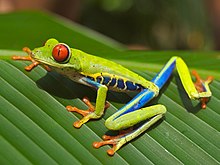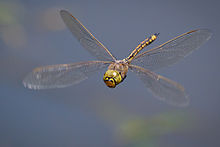
Camouflage is the use of any combination of materials, coloration, or illumination for concealment, either by making animals or objects hard to see, or by disguising them as something else. Examples include the leopard's spotted coat, the battledress of a modern soldier, and the leaf-mimic katydid's wings. A third approach, motion dazzle, confuses the observer with a conspicuous pattern, making the object visible but momentarily harder to locate, as well as making general aiming easier. The majority of camouflage methods aim for crypsis, often through a general resemblance to the background, high contrast disruptive coloration, eliminating shadow, and countershading. In the open ocean, where there is no background, the principal methods of camouflage are transparency, silvering, and countershading, while the ability to produce light is among other things used for counter-illumination on the undersides of cephalopods such as squid. Some animals, such as chameleons and octopuses, are capable of actively changing their skin pattern and colours, whether for camouflage or for signalling. It is possible that some plants use camouflage to evade being eaten by herbivores.

Predation is a biological interaction where one organism, the predator, kills and eats another organism, its prey. It is one of a family of common feeding behaviours that includes parasitism and micropredation and parasitoidism. It is distinct from scavenging on dead prey, though many predators also scavenge; it overlaps with herbivory, as seed predators and destructive frugivores are predators.

A dragonfly is a flying insect belonging to the infraorder Anisoptera below the order Odonata. About 3,000 extant species of true dragonflies are known. Most are tropical, with fewer species in temperate regions. Loss of wetland habitat threatens dragonfly populations around the world. Adult dragonflies are characterized by a pair of large, multifaceted, compound eyes, two pairs of strong, transparent wings, sometimes with coloured patches, and an elongated body. Many dragonflies have brilliant iridescent or metallic colours produced by structural coloration, making them conspicuous in flight. An adult dragonfly's compound eyes have nearly 24,000 ommatidia each.

Echolocation, also called bio sonar, is a biological active sonar used by several animal groups, both in the air and underwater. Echolocating animals emit calls and listen to the echoes of those calls that return from various objects near them. They use these echoes to locate and identify the objects. Echolocation is used for navigation, foraging, and hunting prey.

Batesian mimicry is a form of mimicry where a harmless species has evolved to imitate the warning signals of a harmful species directed at a predator of them both. It is named after the English naturalist Henry Walter Bates, after his work on butterflies in the rainforests of Brazil.

In neuroanatomy, the superior colliculus is a structure lying on the roof of the mammalian midbrain. In non-mammalian vertebrates, the homologous structure is known as the optic tectum, or optic lobe. The adjective form tectal is commonly used for both structures.

Anti-predator adaptations are mechanisms developed through evolution that assist prey organisms in their constant struggle against predators. Throughout the animal kingdom, adaptations have evolved for every stage of this struggle, namely by avoiding detection, warding off attack, fighting back, or escaping when caught.

In ecology, crypsis is the ability of an animal or a plant to avoid observation or detection by other animals. It may be a predation strategy or an antipredator adaptation. Methods include camouflage, nocturnality, subterranean lifestyle and mimicry. Crypsis can involve visual, olfactory or auditory concealment. When it is visual, the term cryptic coloration, effectively a synonym for animal camouflage, is sometimes used, but many different methods of camouflage are employed by animals or plants.

The long-legged bat is a member of the Phyllostomidae family in the order Chiroptera. Both males and females of this species are generally small, with wingspans reaching 80mm with an average weight ranging between 6 and 9 grams. The facial structure of these bats includes a shortened rostrum with a prominent noseleaf. The most defining feature of these bats however, is their long posterior limbs that extend farther than most Phyllostomidae bats. At the ends of these hind legs, the long-legged bat has abnormally large feet equipped with strong claws.

Ambush predators or sit-and-wait predators are carnivorous animals that capture or trap prey via stealth, luring or by strategies utilizing an element of surprise. Unlike pursuit predators, who chase to capture prey using sheer speed or endurance, ambush predators avoid fatigue by staying in concealment, waiting patiently for the prey to get near, before launching a sudden overwhelming attack that quickly incapacitates and captures the prey.

Bats are flying mammals of the order Chiroptera. With their forelimbs adapted as wings, they are the only mammals capable of true and sustained flight. Bats are more agile in flight than most birds, flying with their very long spread-out digits covered with a thin membrane or patagium. The smallest bat, and arguably the smallest extant mammal, is Kitti's hog-nosed bat, which is 29–34 millimetres in length, 150 mm (6 in) across the wings and 2–2.6 g in mass. The largest bats are the flying foxes, with the giant golden-crowned flying fox reaching a weight of 1.6 kg and having a wingspan of 1.7 m.
Ultrasound avoidance is an escape or avoidance reflex displayed by certain animal species that are preyed upon by echolocating predators. Ultrasound avoidance is known for several groups of insects that have independently evolved mechanisms for ultrasonic hearing. Insects have evolved a variety of ultrasound-sensitive ears based upon a vibrating tympanic membrane tuned to sense the bat's echolocating calls. The ultrasonic hearing is coupled to a motor response that causes evasion of the bat during flight.

The Australian emperor dragonfly, also known as the yellow emperor dragonfly, scientific name Anax papuensis, is a species of dragonfly in the Aeshnidae family. It is black with yellow dots along its tail.

Deimatic behaviour or startle display means any pattern of bluffing behaviour in an animal that lacks strong defences, such as suddenly displaying conspicuous eyespots, to scare off or momentarily distract a predator, thus giving the prey animal an opportunity to escape. The term deimatic or dymantic originates from the Greek δειματόω (deimatóo), meaning "to frighten".
Deception in animals is the transmission of misinformation by one animal to another, of the same or different species, in a way that propagates beliefs that are not true.
Echolocation systems of animals, like human radar systems, are susceptible to interference known as echolocation jamming or sonar jamming. Jamming occurs when non-target sounds interfere with target echoes. Jamming can be purposeful or inadvertent, and can be caused by the echolocation system itself, other echolocating animals, prey, or humans. Echolocating animals have evolved to minimize jamming, however; echolocation avoidance behaviors are not always successful.

Pursuit predation is a form of predation in which predators actively give chase to their prey, either solitarily or as a group. It is an alternate predation strategy to ambush predation — pursuit predators rely on superior speed, endurance and/or teamwork to seize the prey, while ambush predators use concealment, luring, exploiting of surroundings and the element of surprise to capture the prey. While the two patterns of predation are not mutually exclusive, morphological differences in an organism's body plan can create an evolutionary bias favoring either type of predation.
Suzanne Amador Kane is a physicist and Professor of Physics and Astronomy at Haverford College. She is well known for her work utilizing video to understand the behavior of various species of birds.

In ecology, hunting success is the proportion of hunts initiated by a predatory organism that end in success. Hunting success is determined by a number of factors such as the features of the predator, timing, different age classes, conditions for hunting, experience, and physical capabilities. Predators selectivity target certain categories of prey, in particular prey of a certain size. Prey animals that are in poor health are targeted and this contributes to the predator's hunting success. Different predation strategies can also contribute to hunting success, for example, hunting in groups gives predators an advantage over a solitary predator, and pack hunters like lions can kill animals that are too powerful for a solitary predator to overcome, like a megaherbivore.






















